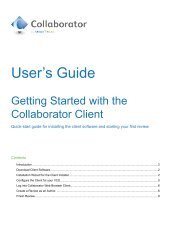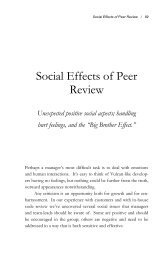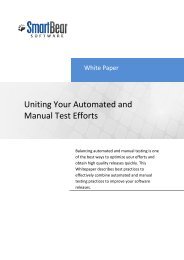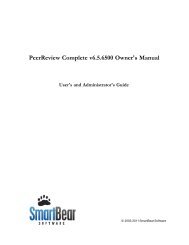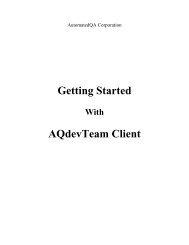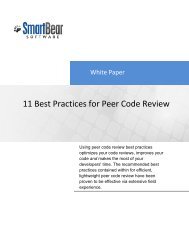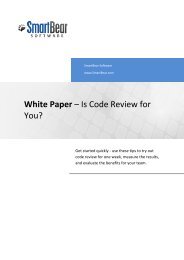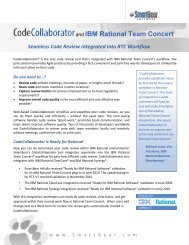Software Peer Reviews: An Executive Overview - SmartBear
Software Peer Reviews: An Executive Overview - SmartBear
Software Peer Reviews: An Executive Overview - SmartBear
You also want an ePaper? Increase the reach of your titles
YUMPU automatically turns print PDFs into web optimized ePapers that Google loves.
<strong>Software</strong> <strong>Peer</strong> <strong>Reviews</strong>: <strong>An</strong><br />
<strong>Executive</strong> <strong>Overview</strong><br />
Karl Wiegers<br />
Process Impact<br />
www.processimpact.com
Process Impact<br />
www.processimpact.com<br />
©Karl Wiegers 2012
Agenda<br />
Define “peer review”<br />
Some benefits from peer reviews and inspections<br />
Different types of peer reviews<br />
The inspection process and participants<br />
<strong>Peer</strong> reviews and managers<br />
Making peer reviews work for you<br />
©Karl Wiegers 2012
What is a <strong>Software</strong> <strong>Peer</strong> Review?<br />
<strong>An</strong> examination of a software work product<br />
by people other than its author in order to<br />
identify defects (departures from<br />
specifications or from standards) and<br />
improvement opportunities.<br />
©Karl Wiegers 2012
Objectives of <strong>Peer</strong> <strong>Reviews</strong><br />
To reveal errors in function, logic, or implementation<br />
To ensure that a work product satisfies its specification<br />
To check for conformance to standards<br />
To give managers insight into product quality<br />
To communicate technical information in a project<br />
To enable someone besides the author to support<br />
or modify a work product<br />
To identify process improvement<br />
opportunities<br />
©Karl Wiegers 2012
<strong>Peer</strong> <strong>Reviews</strong> and Process Improvement<br />
The highest-leverage benefit is process improvement.<br />
It’s cheaper to prevent defects than to find and remove them.<br />
If you don’t correct the causes of defects, they’ll be back.<br />
Review<br />
Observations<br />
Defect Causal<br />
<strong>An</strong>alysis<br />
Process<br />
Improvements<br />
Fewer Defects<br />
Injected<br />
©Karl Wiegers 2012
What Can Be Reviewed?<br />
Short answer:<br />
– any important project artifact that potentially contains<br />
defects<br />
Long answer:<br />
– project plans<br />
– project charter, vision & scope, or marketing<br />
requirements doc<br />
– requirements specifications<br />
– architecture designs<br />
– detailed designs<br />
– source code<br />
– verification and validation plans, test cases<br />
– documentation, on-line help, tutorials<br />
©Karl Wiegers 2012
Who Benefits from <strong>Peer</strong> <strong>Reviews</strong><br />
Developer<br />
Maintainer<br />
Less time spent performing rework<br />
Increased programming productivity<br />
Confidence that the requirements are right<br />
Better techniques learned from other developers<br />
Reduced unit testing and debugging time<br />
Less debugging during integration & system testing<br />
Exchanging information with other team members<br />
Fewer production support demands<br />
More robust designs that tolerate change<br />
Conformance of work products to team standards<br />
More maintainable work products<br />
Better understanding of the product from having<br />
participated in design and code reviews<br />
©Karl Wiegers 2012
Who Benefits from <strong>Peer</strong> <strong>Reviews</strong> (Cont.)<br />
Test Engineer<br />
Requirements<br />
<strong>An</strong>alyst<br />
Project<br />
Manager<br />
can focus testing on finding subtle defects<br />
fewer defects that block continued testing<br />
improved test design and test cases<br />
earlier correction of missing or erroneous<br />
requirements<br />
fewer infeasible and untestable requirements<br />
customer validation of requirements<br />
increased chance of shipping on schedule<br />
earlier awareness of risks and quality issues<br />
reduced risk from staff turnover through cross<br />
training<br />
©Karl Wiegers 2012
Who Benefits from <strong>Peer</strong> <strong>Reviews</strong> (Cont.)<br />
Development<br />
Manager<br />
QA Manager<br />
shortened product development cycle time<br />
reduced field service and customer support costs<br />
reduced lifetime maintenance costs<br />
improved teamwork and collaboration<br />
can judge the testability of product features<br />
shortened system-testing cycles, less retesting<br />
can use review data when making release decisions<br />
quality engineers who understand the product<br />
ability to anticipate QA effort needed<br />
©Karl Wiegers 2012
Some Benefits from <strong>Software</strong> Inspections<br />
Cost Reduction<br />
– Hewlett-Packard: saved $21.4M/year, ROI = 10X<br />
– Xerox: 1 hour of requirements inspection saved 10 rework<br />
hours<br />
– Litton: saved 63.4 staff hours per inspection<br />
Productivity Improvement<br />
– Aetna Insurance: 25% increase in coding productivity<br />
– Hewlett-Packard: reduced time to market by 1.8 months<br />
– IBM: 1 hour of inspection saved 20 testing hours and 82<br />
defect-correction hours<br />
Quality Improvement<br />
– inspections can find 70-90% of all defects<br />
– Bell Northern Research: avoided 33 hours of<br />
maintenance per defect found by inspection<br />
©Karl Wiegers 2012
Relative Cost to Fix a Defect<br />
Relative Cost to Correct a Defect<br />
120<br />
100<br />
80<br />
60<br />
40<br />
20<br />
0<br />
Requirements Design<br />
Code Test Operation<br />
Development Phase<br />
©Karl Wiegers 2012
Cultural Barriers to <strong>Peer</strong> <strong>Reviews</strong><br />
Fear of public ridicule or criticism<br />
Previous negative review experiences<br />
Fear that management will hold defects against the<br />
author<br />
Attitude that “my work doesn’t need reviewing”<br />
Concern that reviews will slow the project down<br />
Review outcomes that managers overrule<br />
Belief that testing is faster<br />
National or team cultures that avoid<br />
personal criticism<br />
©Karl Wiegers 2012
Informal and Formal <strong>Reviews</strong><br />
Informal <strong>Reviews</strong><br />
– No defined process or participant roles<br />
– Usually ad hoc, rather than planned<br />
– Examples: walkthrough, peer deskcheck,<br />
passaround<br />
Formal <strong>Reviews</strong><br />
– Defined review objectives<br />
– Follow a documented review process<br />
– Defined participant roles and trained team<br />
– Checklists, rules, or analysis methods used to find<br />
defects<br />
– Management report produced on product status<br />
– Data collected for quality control and process<br />
management<br />
©Karl Wiegers 2012
<strong>Peer</strong> Review Formality Spectrum<br />
More<br />
Formal<br />
Inspection Team<br />
review<br />
Walkthrough Pair <strong>Peer</strong><br />
programming deskcheck,<br />
passaround<br />
Ad hoc<br />
review<br />
Less<br />
Formal<br />
©Karl Wiegers 2012
The Inspection Process<br />
Initial<br />
Work<br />
Product<br />
Baselined<br />
Work<br />
Product<br />
PLANNING<br />
INSPECTION<br />
MEETING<br />
PREPARATION<br />
FOLLOW-UP<br />
OVERVIEW<br />
MEETING<br />
(optional)<br />
REWORK<br />
©Karl Wiegers 2012
Inspection Participant Roles<br />
Author:<br />
Moderator:<br />
Reader:<br />
Recorder:<br />
Inspector:<br />
Created or maintains work product being inspected<br />
<strong>An</strong>swers questions about the product<br />
Cannot serve as moderator, recorder, or reader<br />
With author, plans the inspection<br />
Leads and controls inspection meetings<br />
Reports inspection results to <strong>Peer</strong> Review Coordinator<br />
Presents work product to other inspectors<br />
Classifies and records issues raised during the meeting<br />
<strong>An</strong>yone else present to find defects in the product<br />
All participants are inspectors<br />
©Karl Wiegers 2012
Other <strong>Peer</strong> Review Methods<br />
Team Review<br />
Skip overview meeting and causal analysis<br />
Author is responsible for follow-up<br />
Records are kept<br />
No reader role: moderator leads team through page by page<br />
Walkthrough<br />
Author leads the discussion; no other roles are defined<br />
Preparation is not required, no records kept<br />
Good for education and brainstorming<br />
Pair Programming<br />
A component of eXtreme Programming<br />
Real-time review by second person in the pair<br />
©Karl Wiegers 2012
Other <strong>Peer</strong> Review Methods (cont.)<br />
<strong>Peer</strong> Deskcheck<br />
Only one reviewer; no team meeting<br />
May or may not keep records<br />
Passaround<br />
Multiple, concurrent peer deskchecks<br />
Need to reconcile conflicting comments without a meeting<br />
Good for asynchronous or remote review, or large review teams<br />
Many people probably won’t participate<br />
Don’t let comments replace human dialogue!<br />
©Karl Wiegers 2012
Using Risk to Select Items to Review<br />
Most mistakes are small; context determines<br />
severity<br />
Risk = (Probability of a defect) x (Impact if there’s<br />
a defect)<br />
Focus limited review effort on high-risk areas<br />
– new technology or techniques<br />
– complex logic or algorithms<br />
– mission- or safety-critical components<br />
– many or dangerous failure modes<br />
– components intended for reuse<br />
– created by less experienced people<br />
– key architectural components<br />
– components that affect multiple parts of product<br />
© Warner Bros.<br />
©Karl Wiegers 2012
Reviewer Perspectives<br />
Author of Dependent<br />
Work Product<br />
Author of Predecessor<br />
Work Product<br />
Author of Item<br />
Being Reviewed<br />
Author of Related<br />
Work Product<br />
©Karl Wiegers 2012
Keeping Inspection Records<br />
Use standard forms.<br />
– Typo List<br />
– Issue Log<br />
– Inspection Summary Report<br />
Perform defect analysis.<br />
– Classify defects by type, origin, and severity.<br />
– Rank the frequency of occurrence of types.<br />
– Identify which types to spend most time looking for.<br />
Track the inspection process.<br />
– Summarize results from multiple inspections.<br />
– <strong>An</strong>alyze inspection results and modify processes.<br />
©Karl Wiegers 2012
Critical Success Factors for <strong>Reviews</strong><br />
obtain management<br />
commitment<br />
review your<br />
early reviews<br />
prefer to have peers, rather than<br />
customers, find defects<br />
identify a review<br />
champion set goals for the<br />
review program<br />
review early and<br />
often, formally<br />
and informally<br />
train reviewers and<br />
review leaders<br />
allocate time in the<br />
project plan for reviews<br />
©Karl Wiegers 2012
10 Signs of Management Commitment<br />
1. Providing resources to establish and sustain the review program.<br />
2. Setting policies, expectations, and goals.<br />
3. Ensuring that project schedules include time for reviews.<br />
4. Making training available.<br />
5. Never using review results to evaluate individuals.<br />
6. Holding people accountable for participating in reviews.<br />
7. Staying the course even in the face of schedule pressure.<br />
8. Running interference with other managers and customers.<br />
9. Respecting the review team’s document appraisal.<br />
10. Asking for status reports on the program.<br />
©Karl Wiegers 2012
Common <strong>Peer</strong> Review Traps<br />
<strong>Reviews</strong> are skipped under time pressure.<br />
People think their projects are too small to benefit from<br />
reviews.<br />
Reviewers aren’t adequately prepared.<br />
Meetings drift into finding solutions, not problems.<br />
Reviewers criticize the author, not the product.<br />
Reviewers turn into lecturers.<br />
Authors become defensive.<br />
Review teams are too large.<br />
©Karl Wiegers 2012
<strong>Peer</strong> Review Tools<br />
<strong>Peer</strong> review tools save time and make it easier to collaborate on<br />
requirements, design documents, and code<br />
Code Review - CodeCollaborator<br />
– Automate tedious review aspects (file packaging and code review management)<br />
– Associate comments with lines of code<br />
– Point out defects, discuss code, and follow conversation threads<br />
– Collect and manage comments automatically<br />
– Facilitate review with team members in remote locations<br />
– Capture metrics, generate reports, provide audit trail to document code changes<br />
– Integrate with 16 SCM tools<br />
Document and Code Review – <strong>Peer</strong>Review Complete<br />
– One tool for document and code review<br />
– Allow the extended development team to review critical documents affordably<br />
– Faster, easier, and more efficient Microsoft Word and PDF document review<br />
• eliminate comment reconciliation step<br />
• see comments from all reviewers in one place<br />
– Use electronic signatures to meet regulatory and internal mandates
<strong>Software</strong> <strong>Peer</strong> <strong>Reviews</strong><br />
You cannot review quality in.<br />
You must build quality in.<br />
©Karl Wiegers 2012
Further Reading<br />
Gilb, Tom and Dorothy Graham. <strong>Software</strong> Inspection. Reading, Mass.: Addison-<br />
Wesley, 1993.<br />
Radice, Ronald A. High Quality Low Cost <strong>Software</strong> Inspections. <strong>An</strong>dover,<br />
Massachusetts: Paradoxicon Publishing, 2002.<br />
Wheeler, David A., Bill Brykczynski, and Reginald N. Meeson, Jr. <strong>Software</strong><br />
Inspection: <strong>An</strong> Industry Best Practice. Los Alamitos, California: IEEE Computer<br />
Society Press, 1996.<br />
Wiegers, Karl. “The Seven Deadly Sins of <strong>Software</strong> <strong>Reviews</strong>,” <strong>Software</strong><br />
Development, vol. 6, no. 3 (March 1998), pp. 44-47.<br />
Wiegers, Karl E. <strong>Peer</strong> <strong>Reviews</strong> in <strong>Software</strong>: A Practical Guide. Reading, Mass.:<br />
Addison-Wesley, 2002.<br />
©Karl Wiegers 2012
ADDENDUM SLIDES<br />
©Karl Wiegers 2012
Types of Project <strong>Reviews</strong><br />
Educational Review<br />
– bring other stakeholders up to speed<br />
Management, Readiness, or Gate Review<br />
– inform managers about project so they can<br />
decide to proceed or make changes<br />
<strong>Peer</strong> Review<br />
– look for defects in a work product<br />
Post-Project Review (aka “Retrospective”)<br />
– reflect on a completed project to learn lessons for the future<br />
Status Review<br />
– update project manager and team on project progress, risks, etc.<br />
©Karl Wiegers 2012
The <strong>Peer</strong> Review Process Owner<br />
Usually a mid-level manager<br />
Leads development of peer review process and<br />
process assets<br />
Provides continuity for ongoing improvement of review<br />
process<br />
Establishes and enforces review policies<br />
Monitors conduct and results of reviews<br />
©Karl Wiegers 2012
The <strong>Peer</strong> Review Coordinator<br />
Experienced inspector and moderator<br />
Coaches teams and moderators to perform<br />
reviews effectively<br />
Schedules training sessions<br />
Collects, analyzes, and reports on<br />
inspection data<br />
Works with Process Owner to improve<br />
the review process<br />
©Karl Wiegers 2012
<strong>Peer</strong> <strong>Reviews</strong> and Managers<br />
The conventional wisdom is “no managers.”<br />
– can inhibit discussion<br />
– author’s fear of retribution<br />
I think it depends.<br />
– first-line manager can participate at author’s invitation<br />
– managers can often contribute technically<br />
– key issue is mutual respect and trust<br />
Managers need their work reviewed too.<br />
– project charters, plans, schedules<br />
– soliciting review is a culture builder<br />
©Karl Wiegers 2012
<strong>Peer</strong> Review Do’s<br />
Regard finding a defect as a “good catch.”<br />
Avoid being distracted by style issues.<br />
Emphasize finding — not fixing — defects during the<br />
review.<br />
Make everyone’s work subject to review.<br />
Check the significant portions of the material first.<br />
Train the reviewers.<br />
Emphasize defect prevention.<br />
Use reliable tools that ease the review process and<br />
promote collaboration<br />
©Karl Wiegers 2012
<strong>Peer</strong> Review Don’ts<br />
Use data collected from reviews to punish<br />
or reward individuals.<br />
Attribute defect data to individual authors.<br />
Track who finds the most defects.<br />
Use reviews to find scapegoats for project problems.<br />
Use untrained or reluctant review moderators.<br />
Include participants who are not there to find defects.<br />
©Karl Wiegers 2012
Thanks! Get Your Free 30-day Trials<br />
Work together seamlessly anytime, anywhere<br />
with a full-featured code review tool that<br />
enables and encourages communication,<br />
collaboration and quality.<br />
Start your free trial now!<br />
Use one tool to ensure that document and<br />
code reviews get done, comments aren’t lost,<br />
and the right people sign off! <strong>Peer</strong>Review<br />
Complete combines a revolutionary peer<br />
review process with electronic signatures.<br />
Start you free trial now!<br />
Start your free trial now!<br />
©Karl Wiegers 2012







